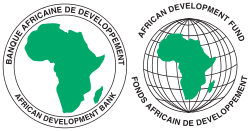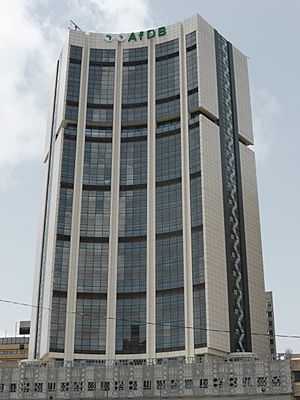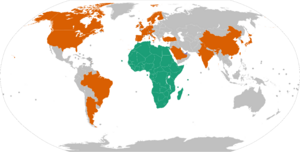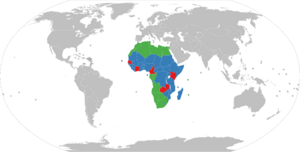African Development Bank facts for kids
|
Banque africaine de développement
|
|
 |
|

AfDB headquarters building in Abidjan
|
|
| Abbreviation | AfDB |
|---|---|
| Formation | September 10, 1964 |
| Type | International organization |
| Legal status | Treaty |
| Purpose | Regional development |
| Headquarters | Abidjan, Ivory Coast |
|
Membership
|
81 countries |
|
President
|
Akinwumi Adesina |
|
Main organ
|
Board of Executive Directors |
|
Staff
|
2,123 as of 31 December 2022 |
The African Development Bank Group (AfDB), also known as BAD in French, is a big financial group. It helps African governments and private companies. They invest in projects across African countries. Its main office is in Abidjan, Ivory Coast.
The AfDB was started in 1964. It was created by the Organisation of African Unity. This organization later became the African Union. The AfDB Group has three main parts: the African Development Bank, the African Development Fund, and the Nigeria Trust Fund.
Contents
- How the AfDB Started
- Parts of the AfDB Group
- How the AfDB is Managed
- AfDB's Unit of Account
- What the AfDB Aims to Do
- How the AfDB Works
- AfDB's Role in Africa
- Current Focus and Future Plans
- Future Outlook
- African Development Bank Annual Conferences
- Member Countries
- Regional Offices
- Countries with the Most Voting Power
- United Nations Development Business
- See also
How the AfDB Started
After many African countries became independent, they wanted to work together more. They decided to create a special bank for development. This bank would help African countries grow.
An agreement to start the bank was signed on August 4, 1963. Twenty-three African governments agreed to it. The bank officially began on September 10, 1964. Its first meeting was in Lagos, Nigeria, in November 1964. The main office opened in Abidjan, Ivory Coast, in March 1965. The bank started its work on July 1, 1966.
At first, only African countries could join. But in 1982, countries from outside Africa were allowed to join too. This helped the bank offer more loans. It also brought in new ideas and connections to other markets.
From 2003 to 2014, the bank moved its main office. It operated from Tunis, Tunisia. This was because of political problems in Ivory Coast. Once the problems were over, the bank moved back to Abidjan in late 2013. By June 2015, most of its staff had returned.
Since it started, the AfDB has helped fund many projects. It has provided billions of dollars for development. In 2019, the bank's total capital was reported as $208 billion.
In 2022, Africa's economic growth slowed down a bit. However, the African Development Fund (ADF) received a big boost. It got US$8.9 billion to give out as loans and grants. A large part of this, US$429 million, was for projects related to climate change. The bank approved many new projects. It focused on areas like renewable energy, food security, and infrastructure. The AfDB also kept its top credit rating.
Parts of the AfDB Group
The African Development Bank Group includes two other important parts. These are the African Development Fund (ADF) and the Nigeria Trust Fund (NTF).
African Development Fund (ADF)
The African Development Fund was created in 1972. It started helping countries in 1974. The ADF gives loans and grants to poorer African countries. These countries might not be able to get loans from the main AfDB. The ADF's main goal is to help reduce poverty.
Twenty-four countries from outside Africa, along with the AfDB, are members of the ADF. The United Kingdom is the largest contributor to the ADF. The United States and Japan also contribute a lot.
The ADF's work is guided by a Board of Directors. Its money mainly comes from contributions from non-African member countries. These funds are usually refilled every three years. The ADF offers loans with no interest. It has a small service charge and a very long repayment period of 50 years. This includes a 10-year grace period before repayments start.
Nigeria Trust Fund (NTF)
The Nigeria Trust Fund was set up in 1976. It was started by the Nigerian government with $80 million. The NTF helps the poorest members of the AfDB.
The NTF provides money for important projects. These projects help with economic and social development. They are for countries that need special financial help. In 1996, the NTF had $432 million. It offers loans with a 4% interest rate. The repayment period is 25 years, with a five-year grace period.
How the AfDB is Managed
The AfDB is managed by a Board of Executive Directors. These directors represent the member countries. How much voting power each country has depends on how much money it contributes. African countries have about 60% of the voting power. Non-African countries have about 40%. Nigeria has the most voting power among African countries.
Dr. Akinwumi Adesina is the current President of the African Development Bank Group. He became President on September 1, 2015. He also leads the Boards of both the African Development Bank and the African Development Fund. Before this, Dr. Adesina was Nigeria's Minister of Agriculture. He was reelected for a second five-year term on August 27, 2020.
Each member country's Minister of Finance or Planning represents them at the AfDB. These ministers form the Board of Governors. They meet once a year to make big decisions. They decide on the bank's leaders and main goals. The Governors usually choose someone from their country to be on the Board of Executive Directors.
The Board of Executive Directors makes daily decisions. They decide which loans and grants to approve. They also set the rules for the AfDB's work. Every member country has a representative on the Board. However, their influence depends on how much money their country gives to the AfDB.
AfDB's Unit of Account
| ADB Unit of Account | |
|---|---|
| ISO 4217 Code | XUA |
| User(s) | African Development Bank Group (African Development Bank, African Development Fund, Nigeria Trust Fund) |
The African Development Bank uses a special accounting unit. It is called the ADB Unit of Account (XUA). This unit is not used by people for daily money exchanges. It is used for keeping financial records between member countries.
What the AfDB Aims to Do
The main goal of the AfDB is to fight poverty in Africa. It also aims to improve living conditions for people. It does this by encouraging investments. These investments come from governments and private companies. They support projects that help with economic and social development.
How the AfDB Works
The AfDB has several key jobs:
- It gives loans and makes investments. These help African countries grow economically and socially.
- It offers technical help for development projects. This means providing expert advice and training.
- It encourages both public and private money to be invested in development.
- It helps African countries plan their development policies.
The AfDB also pays special attention to projects that connect different countries. These projects help bring African regions closer together.
AfDB's Role in Africa
The AfDB helps African countries develop their economies and societies. It lends about $3 billion to African countries each year. The bank focuses on helping women and improving education. It also supports efforts to reduce debt for poorer countries.
The bank's main office is back in Abidjan, Ivory Coast. As of 2016, it had about 1,865 employees. It has 80 member countries. Fifty-four of these are in Africa. The other 26 are from America, Europe, and Asia.
Current Focus and Future Plans
The AfDB wants to be more focused on specific countries. It also wants to be more selective in its projects. This means it will choose projects that have the biggest impact.
Historically, the AfDB has invested a lot in infrastructure. This includes power supply, water, sanitation, transport, and communications. This focus on infrastructure is still very important. In 2005, about 40% of the AfDB's approvals were for infrastructure projects. This focus is expected to grow even more.
Projects that connect different regions are also key. The AfDB believes that working together makes Africa stronger. It helps African countries compete better globally. The AfDB is seen as a good organization to support these regional projects.
The AfDB also plays a big role in helping Africa fight HIV/AIDS. It has several ways to help:
- Building stronger organizations and policies.
- Training people to carry out national AIDS plans.
- Supporting prevention and control efforts. This includes education and testing.
- Speaking up at international meetings to get more support.
- Working with other groups to fight the pandemic.
The bank has contributed over UA 500 million to fight HIV/AIDS. It also helps prepare projects to get funding from other sources. This means the AfDB helps make projects possible, even if it doesn't fund them directly.
Energy projects are becoming more important for the AfDB. Many parts of Africa lack access to energy. The bank is working on an energy policy. It is also helping with clean energy investments.
In 2010, the African Development Institute became the main center for training. It helps improve how the AfDB's projects work.
In response to the global coronavirus pandemic, the AfDB has been selling "social bonds." This helps raise money for poorer countries to deal with the pandemic. Since 2017, it has issued seven such bonds.
In 2023, the AfDB started releasing economic reports for each country. These reports help African leaders plan for climate change and green growth. In February 2025, the AfDB and Interpol agreed to work together. They want to fight corruption across Africa. This partnership aims to help countries build strong systems against financial crime.
Future Outlook
The AfDB's financial health has improved a lot since 1995. It continues to work on improving its operations. Experts suggest the bank should focus strongly on infrastructure.
The AfDB's lending activities have grown. Between 2005 and 2006, its lending increased by over 30%. Its private sector operations also doubled. The AfDB has special tasks from other organizations. These include leading efforts in infrastructure and regional integration. This has made the AfDB more visible.
Many people in African countries prefer aid from the African Development Bank. This shows that they value the bank's work.
While there has been progress in Africa, many people still live in poverty. Diseases like AIDS also pose big challenges. However, studies show that most African countries can make good progress. They can work towards goals like reducing poverty and improving access to clean water.
African Development Bank Annual Conferences
The African Development Bank holds annual conferences. In May 2017, its 4th conference outside Africa was held in India. Previous conferences outside Africa were in Spain, China, and Portugal.
Member Countries
The AfDB has two types of member countries: regional (African) and non-regional (from other parts of the world).
African Member Countries
All countries in the African Union are eligible for NTF benefits.
Countries Eligible for ADF Resources Only
Countries Eligible for Both ADB and ADF Resources
Countries Eligible for ADB Resources Only
Non-African Member Countries
Regional Offices
| Region | Headquarters |
|---|---|
| Central Africa | |
| East Africa | |
| North Africa | |
| Southern Africa | |
| West Africa |
Countries with the Most Voting Power
This table shows the 20 countries with the most voting power at the African Development Bank as of September 2021.
| Rank | Country | Voting powers (% of total) |
|---|---|---|
| World | 100.000 | |
| 1 | 10.077 | |
| 2 | 7.581 | |
| 3 | 6.284 | |
| 4 | 5.863 | |
| 5 | 5.758 | |
| 6 | 4.779 | |
| 7 | 4.395 | |
| 8 | 4.386 | |
| 9 | 4.299 | |
| 10 | 3.062 | |
| 11 | 2.780 | |
| 12 | 2.749 | |
| 13 | 2.552 | |
| 14 | 2.083 | |
| 15 | 1.988 | |
| 16 | 1.802 | |
| 17 | 1.683 | |
| 18 | 1.660 | |
| 19 | 1.389 | |
| 20 | 1.351 |
United Nations Development Business
The United Nations started Development Business in 1978. It helps share information about tenders and contracts. Many big development banks, including the African Development Bank, use it. This publication helps them announce projects and find partners.
See also
 In Spanish: Banco Africano de Desarrollo para niños
In Spanish: Banco Africano de Desarrollo para niños
- African Economic Outlook
- African, Caribbean and Pacific Group of States
- Asian Development Bank
- Asian Infrastructure Investment Bank
- European Investment Bank
- Caribbean Development Bank
- CAF – Development Bank of Latin America and the Caribbean
- Islamic Development Bank
- Inter-American Development Bank
- New Development Bank



